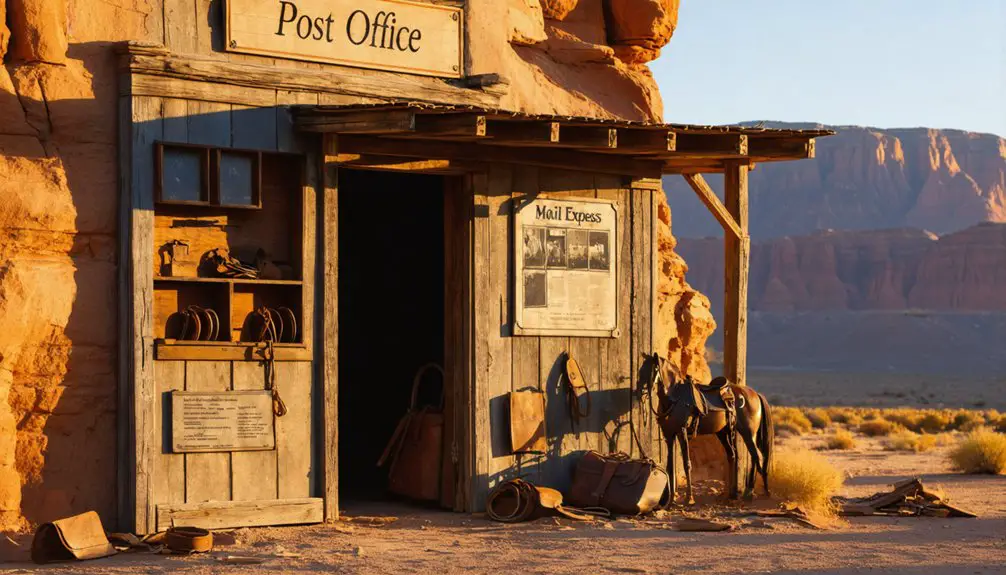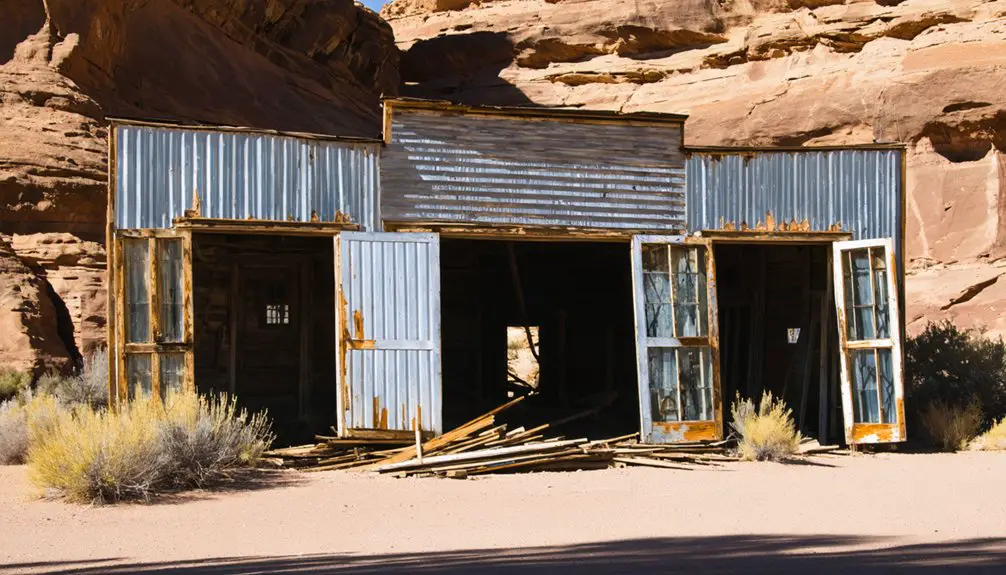You’ll find Castle Rock’s ghost town remains in Utah’s Summit County, where it began as an essential 1860 Pony Express station at Echo Canyon’s head. The settlement supported 80,000 Mormon pioneers and became a key railroad stop by 1872. While most original structures are gone, including the Pony Express station and schoolhouse, you can still spot Rock Castle and an old gas station among scattered foundations. This forgotten hub’s evolution mirrors the dramatic shifts of America’s western frontier.
Key Takeaways
- Castle Rock began as a Pony Express station in 1860 at Echo Canyon’s head, serving as a vital relay point for mail delivery.
- The town grew with trading networks and railroad development but declined when mining operations drew population elsewhere.
- After the local school closed in 1937, Castle Rock experienced rapid population loss and eventual abandonment.
- Only a few original structures remain today, including Rock Castle and an old gas station amid scattered building foundations.
- The site now contains an automotive junkyard, with most historic buildings lost, including the original Pony Express station.
The Rise of a Pony Express Hub

As the Pony Express sought to establish essential communication links across the American frontier, Castle Rock station emerged as a significant relay point in 1860 at the head of Echo Canyon.
You’ll find this strategic location, also known as Frenchies, served as a crucial contract stop where fresh horses awaited exhausted riders every 7-10 miles of their journey.
The log-built station operated as part of an intricate network of nearly 190 outposts stretching across the nation’s communication routes.
At Castle Rock, dedicated station keepers managed the remote post, tending to approximately 500 horses that enabled riders to cover up to 125 miles daily.
Originally positioned 1.5 miles down Echo Canyon, the station later moved up the canyon in 1867, marking the beginning of a settlement that would shape Utah’s frontier development.
Letters carried by riders cost customers between $2 to $10 per piece, a significant expense for the era.
The station’s operations came to an end when the telegraph service replaced the Pony Express in late 1861, forever changing the landscape of frontier communication.
Life Along the Mormon Trail
When Brigham Young organized the Mormon migration in 1846, he established a rigorous system of companies divided into groups of 100s, 50s, and 10s to maintain order during the 1,040-mile journey west.
Daily routines included morning and evening prayers to maintain spiritual unity among the travelers.
You’d find yourself traveling about 13 miles per day alongside fellow pioneers, stopping at temporary camps that became crucial hubs for pioneer socialization and religious gatherings.
At supply points like Fort Laramie, you’d pay premium prices: 25 cents per pound of flour, $1 for each yard of cotton, and up to $20 for a cow.
The journey’s challenges included ferrying wagons across rivers and steering through Echo Canyon’s steep terrain. The pioneers chose the north side of Platte to avoid competing for resources with other wagon trains.
Communal decision making proved essential as groups chose campsites, adjusted routes, and supported one another until reaching their destination in the Salt Lake Valley in July 1847.
From Trading Post to Ghost Town
Founded in 1860 as Head of Echo Canyon, Castle Rock began its journey as an essential Pony Express station in Summit County, Utah.
You’ll find its growth closely tied to the expanding trading networks, as families settled to serve travelers and later, railroad personnel. By 1872, the Union Pacific Railroad‘s arrival strengthened the town’s commercial position. Similar to other trading posts of the era, the establishment offered credit to customers to maintain steady business relationships.
The town’s economic shifts paralleled the region’s evolving dynamics. While Castle Rock initially thrived as “Frenchies,” named after a French trapper who acquired the station building, mining developments in nearby areas gradually drew population and commerce elsewhere. Like many Utah towns of the era, it became known as a place where Butch Cassidy’s gang would seek refuge.
After the school’s closure in 1937, the community’s decline accelerated. Today, you’ll discover only remnants of its trading post past – abandoned structures and railroad artifacts, while the site serves as an automotive junkyard.
Notable Structures and Remnants
Today, Castle Rock’s remaining structures paint a sparse portrait of its once-bustling past. The historical architecture has largely vanished, with preservation challenges stemming from decades of private ownership and abandonment.
The most notable surviving structure is the Rock Castle, which stands as the last remnant of the early mining era.
You’ll find the town’s gas station among the few original buildings still standing, while most other structures have succumbed to time.
Much like how Castle Rock Entertainment produces films that tell stories, these ruins silently narrate tales of the American West.
The site’s most significant historical losses include:
- The Head of Echo Canyon Pony Express station, relocated in 1867
- The Union Pacific Railroad stop structures from 1872
- The original schoolhouse that operated from 1872 to 1937
Cache Cave, though not part of the town proper, remains as a monument to pioneer history with its preserved inscriptions.
The landscape now hosts an automotive junkyard, where you might spot scattered building foundations beneath decades of accumulated debris.
Legacy in Summit County History
Through its pivotal role in western expansion, Castle Rock emerged as a microcosm of Summit County’s transportation and settlement history. You’ll find its story woven into every major frontier development, from serving 80,000 Mormon immigrants to supporting the Pony Express and transcontinental railroad. Like Echo Canyon, it served as a natural pathway for Native Americans and early explorers. Messages sent via Pony Express service cost approximately $85 in today’s currency.
The town’s community resilience shines through its 65-year-running school and the Echo Church, which served residents until 1963.
As Summit County evolved, Castle Rock adapted to economic changes, shifting from a bustling Pony Express station to a railroad stop, and finally to a quiet ghost town.
Today, you can trace this transformation through artifacts like discovered gold coins and letters, while the site’s current use as an automotive junkyard reflects the area’s continuing commercial adaptability.
Frequently Asked Questions
What Dangerous Wildlife Was Commonly Encountered by Early Castle Rock Settlers?
You’d face aggressive black bears, wolves, and bobcats while dealing with frequent coyote encounters. Rattlesnake sightings posed serious risks, especially during droughts when they’d venture closer to settlements seeking water.
How Many Students Typically Attended the Castle Rock School?
You’d have found 10 to 35 students braving educational challenges to attend Castle Rock’s one-room schoolhouse, where attendance fluctuated with mining cycles and seasonal ranch work throughout each session.
What Were the Average Temperatures and Weather Conditions in Castle Rock?
You’d experience dramatic temperature fluctuations, from winter lows around 23°F to summer highs reaching 92°F. Seasonal weather brings cold, snowy winters and hot, dry summers with sporadic precipitation.
Did Any Famous Outlaws or Gunfighters Ever Pass Through Castle Rock?
You’ll find Butch Cassidy and the Wild Bunch used nearby trails, but no famous outlaws or legendary gunfighters are directly documented as passing through Castle Rock specifically, unlike Castle Gate.
What Happened to the Original Families Who Settled in Castle Rock?
Pioneering precarious paths, you’ll find settler descendants moved to nearby towns like Orangeville and Huntington, as historical records show families gradually left their isolated homesteads for better opportunities and community connections.
References
- https://en.wikipedia.org/wiki/Castle_Rock
- https://www.legendsofamerica.com/ut-castlegate/
- https://www.moabhappenings.com/Archives/historic1009GhostTownRuins.htm
- https://en.wikipedia.org/wiki/Castle_Gate
- https://jacobbarlow.com/2015/11/23/castle-rock-utah/
- https://pinintheatlas.com/travel-blogs/pony-express-reviving-the-ghosts-from-an-1860s-dream/
- https://motoidaho.com/articles/utah-wyoming-pony-express-ride/
- https://en.wikipedia.org/wiki/Pony_Express
- https://expeditionutah.com/featured-trails/pony-express-trail/utah-pony-express-stations/
- https://historytogo.utah.gov/mormon-trail-exhibit/



